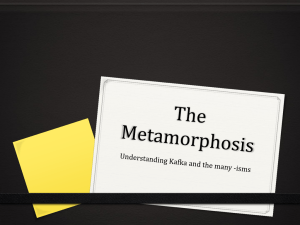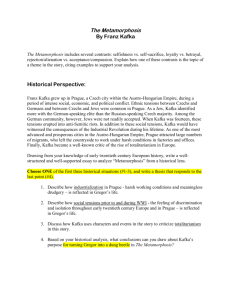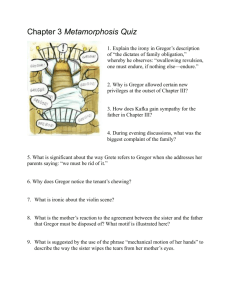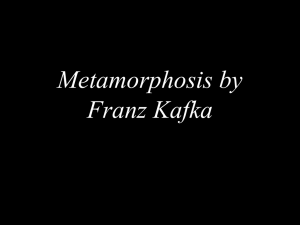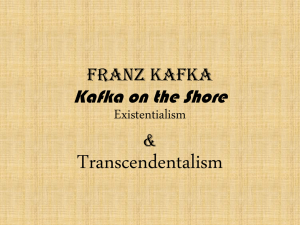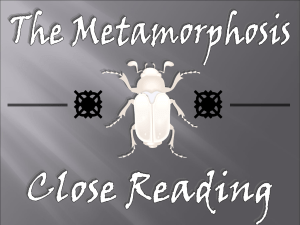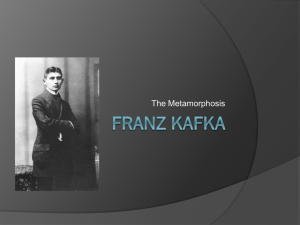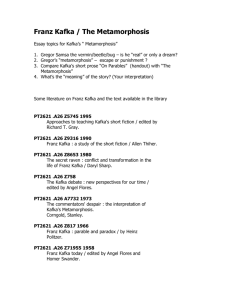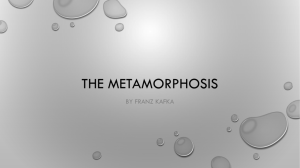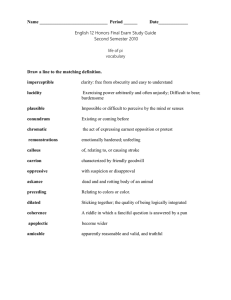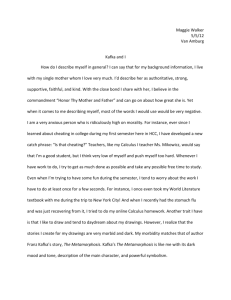Nabokov on Metamorphosis
advertisement
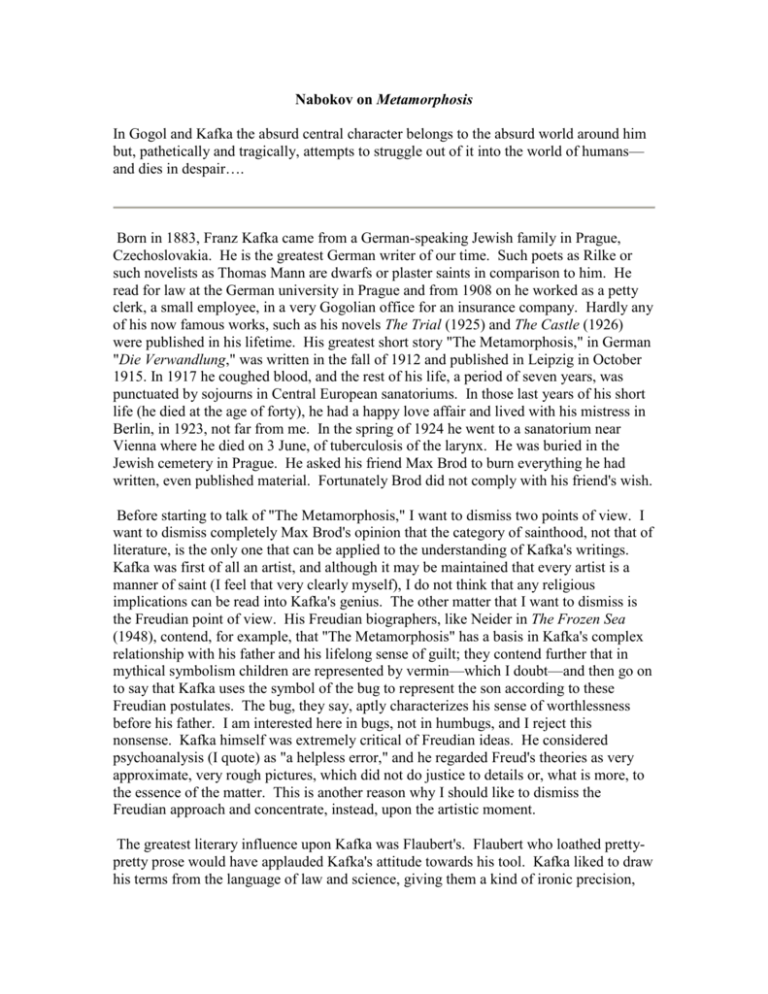
Nabokov on Metamorphosis In Gogol and Kafka the absurd central character belongs to the absurd world around him but, pathetically and tragically, attempts to struggle out of it into the world of humans— and dies in despair…. Born in 1883, Franz Kafka came from a German-speaking Jewish family in Prague, Czechoslovakia. He is the greatest German writer of our time. Such poets as Rilke or such novelists as Thomas Mann are dwarfs or plaster saints in comparison to him. He read for law at the German university in Prague and from 1908 on he worked as a petty clerk, a small employee, in a very Gogolian office for an insurance company. Hardly any of his now famous works, such as his novels The Trial (1925) and The Castle (1926) were published in his lifetime. His greatest short story "The Metamorphosis," in German "Die Verwandlung," was written in the fall of 1912 and published in Leipzig in October 1915. In 1917 he coughed blood, and the rest of his life, a period of seven years, was punctuated by sojourns in Central European sanatoriums. In those last years of his short life (he died at the age of forty), he had a happy love affair and lived with his mistress in Berlin, in 1923, not far from me. In the spring of 1924 he went to a sanatorium near Vienna where he died on 3 June, of tuberculosis of the larynx. He was buried in the Jewish cemetery in Prague. He asked his friend Max Brod to burn everything he had written, even published material. Fortunately Brod did not comply with his friend's wish. Before starting to talk of "The Metamorphosis," I want to dismiss two points of view. I want to dismiss completely Max Brod's opinion that the category of sainthood, not that of literature, is the only one that can be applied to the understanding of Kafka's writings. Kafka was first of all an artist, and although it may be maintained that every artist is a manner of saint (I feel that very clearly myself), I do not think that any religious implications can be read into Kafka's genius. The other matter that I want to dismiss is the Freudian point of view. His Freudian biographers, like Neider in The Frozen Sea (1948), contend, for example, that "The Metamorphosis" has a basis in Kafka's complex relationship with his father and his lifelong sense of guilt; they contend further that in mythical symbolism children are represented by vermin—which I doubt—and then go on to say that Kafka uses the symbol of the bug to represent the son according to these Freudian postulates. The bug, they say, aptly characterizes his sense of worthlessness before his father. I am interested here in bugs, not in humbugs, and I reject this nonsense. Kafka himself was extremely critical of Freudian ideas. He considered psychoanalysis (I quote) as "a helpless error," and he regarded Freud's theories as very approximate, very rough pictures, which did not do justice to details or, what is more, to the essence of the matter. This is another reason why I should like to dismiss the Freudian approach and concentrate, instead, upon the artistic moment. The greatest literary influence upon Kafka was Flaubert's. Flaubert who loathed prettypretty prose would have applauded Kafka's attitude towards his tool. Kafka liked to draw his terms from the language of law and science, giving them a kind of ironic precision, with no intrusion of the author's private sentiments; this was exactly what Flaubert's method through which he achieved a singular poetic effect. The hero of "The Metamorphosis" is Gregor Samsa (pronounced Zamza), who is the son of middle-class parents in Prague, Flaubertian philistines, people interested only in the material side of life and vulgarians in their tastes. Some five years before, old Samsa lost most of his money, whereupon his son Gregor took a job with one of his father's creditors and became a traveling salesman in cloth. His father then stopped working altogether, his sister Grete was too young to work, his mother was ill with asthma; thus young Gregor not only supported the whole family but also found for them the apartment they are now living in. This apartment, a flat in an apartment house, in Charlotte Street to be exact, is divided into segments as he will be divided himself. We are in Prague, central Europe, in the year 1912; servants are cheap so the Samsas can afford a servant maid, Anna, aged sixteen (one year younger than Grete), and a cook. Gregor is mostly away traveling, but when the story starts he is spending a night at home between two business trips, and it is then that the dreadful thing happened. "As Gregor Samsa awoke one morning from a troubled dream he found himself transformed in his bed into a monstrous insect. He was lying on his hard, as it were armor-plated, back and when he lifted his head a little he could see his dome-like brown belly divided into corrugated segments on top of which the bed quilt could hardly keep in position and was about to slide off completely. His numerous legs, which were pitifully thin compared to the rest of his bulk, flimmered [flicker + shimmer] helplessly before his eyes. Now what exactly is the "vermin" into which poor Gregor, the seedy commercial traveler, is so suddenly transformed? It obviously belongs to the branch of "jointed leggers" (Arthropoda), to which insects, and spiders, and centipedes, and crustaceans belong. If the "numerous little legs" mentioned in the beginning mean more than six legs, then Gregor would not be an insect from a zoological point of view. But I suggest that a man awakening on his back and finding he has as many as six legs vibrating in the air might feel that six was sufficient to be called numerous. We shall therefore assume that Gregor has six legs, that he is an insect. Next question: what insect? Commentators say cockroach, which of course does not make sense. A cockroach is an insect that is flat in shape with large legs, and Gregor is anything but flat: he is convex on both sides, belly and back, and his legs are small. He approaches a cockroach in only one respect: his coloration is brown. That is all. Apart from this he has a tremendous convex belly divided into segments and a hard rounded back suggestive of wing cases. In beetles these cases conceal flimsy little wings that can be expanded and then may carry the beetle for miles and miles in a blundering flight. Curiously enough, Gregor the beetle never found out that he had wings under the hard covering of his back. (This is a very nice observation on my part to be treasured all your lives. Some Gregors, some Joes and Janes, do not know that they have wings.) Further, he has strong mandibles. He uses these organs to turn the key in a lock while standing erect on his hind legs, on his third pair of legs (a strong little pair), and this gives us the length of his body, which is about three feet long. In the course of the story he gets gradually accustomed to using his new appendages—his feet, his feelers. This brown, convex, dog-sized beetle is very broad. I should imagine him to look like this: In the original German text the old charwoman calls him Mistkäfer, a "dung beetle." It is obvious that the good woman is adding the epithet only to be friendly. He is not, technically, a dung beetle. He is merely a big beetle. (I must add that neither Gregor nor Kafka saw that beetle any too clearly.) Let us look closer at the transformation. The change, though shocking and striking, is not quite so odd as might be assumed at first glance. A commonsensical commentator (Paul L. Landsberg in The Kafka Problem [1946], ed. Angel Flores) notes that "When we go to bed in unfamiliar surroundings, we are apt to have a moment of bewilderment upon awakening, a sudden sense of unreality, and this experience must occur over and over again in the life of a commercial traveler, a manner of living that renders impossible any sense of continuity." The sense of reality depends upon continuity, upon duration. After all, awakening as an insect is not much different from awakening as Napoleon or George Washington. (I knew a man who awoke as the Emperor of Brazil.) On the other hand, the isolation, and the strangeness, of so-called reality—this is, after all, something which constantly characterizes the artist, the genius, the discoverer. The Samsa family around the fantastic insect is nothing else than mediocrity surrounding genius.
